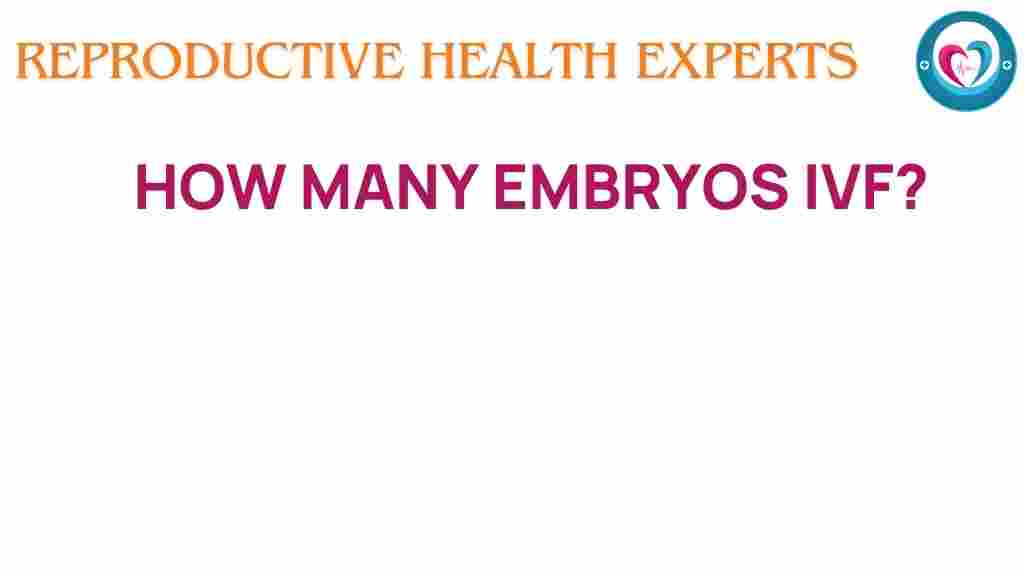The Intriguing Question: How Many Embryos Should You Transfer in IVF?
In the realm of reproductive health, the decision regarding how many embryos to transfer during In Vitro Fertilization (IVF) is a critical one. This choice can significantly influence the success rates of fertility treatment, the health of the mother, and the well-being of the future child. As couples navigate the complex world of assisted reproduction and family planning, understanding the implications of embryo transfer becomes essential. In this article, we will explore the factors that influence the number of embryos transferred, the associated risks and benefits, and the options available to couples undergoing IVF.
Understanding IVF and Embryo Transfer
IVF is a popular fertility treatment that involves several steps, including ovarian stimulation, egg retrieval, fertilization, and embryo culture. Once the embryos reach a certain stage of development, they are ready for transfer into the uterus. This procedure is known as embryo transfer and is a pivotal moment in the IVF process.
The number of embryos transferred during IVF can vary based on several factors, including:
- Age of the woman
- Quality of the embryos
- Previous IVF attempts
- Underlying fertility issues
- Personal preferences and ethical considerations
Factors Influencing the Number of Embryos Transferred
When considering how many embryos to transfer, it is crucial to assess various factors that may impact the outcome:
1. Age of the Woman
The age of the woman undergoing IVF plays a significant role in determining the number of embryos to transfer. Younger women generally have higher success rates with a single embryo transfer due to better egg quality. In contrast, older women may have lower success rates, prompting some doctors to recommend transferring two or more embryos to increase the chances of pregnancy.
2. Quality of the Embryos
The quality of the embryos is another vital consideration. High-quality embryos have a better chance of implantation and successful pregnancy. In cases where the embryos are of lower quality, transferring more embryos might be suggested to enhance the likelihood of success.
3. Previous IVF Attempts
Women who have undergone multiple cycles of IVF may have different considerations. If previous attempts have not resulted in pregnancy, transferring more embryos may be recommended. However, this decision should be made after careful consultation with a fertility specialist.
4. Underlying Fertility Issues
Couples facing specific fertility challenges may also need to consider how many embryos to transfer. For example, individuals with diminished ovarian reserve or male fertility factors may benefit from transferring multiple embryos.
5. Personal Preferences and Ethical Considerations
Some couples may have personal or ethical beliefs that guide their decisions on embryo transfer. Discussing these values with a healthcare provider can help in making informed choices that align with the couple’s family planning goals.
The Risks and Benefits of Transferring Multiple Embryos
While transferring more than one embryo can increase the chances of pregnancy, it also carries certain risks that should be weighed carefully.
Benefits
- Increased Success Rates: Transferring multiple embryos can enhance the likelihood of at least one embryo implanting successfully.
- Time Efficiency: Couples may achieve pregnancy more quickly, reducing the emotional and financial stress of undergoing multiple IVF cycles.
Risks
- Multiple Pregnancies: Transferring more embryos significantly increases the risk of multiple pregnancies (twins, triplets, etc.), which can pose health risks to both the mother and the babies.
- Higher Health Risks: Multiple pregnancies are associated with increased risks of complications such as preterm birth, gestational diabetes, and preeclampsia.
Step-by-Step Process of Embryo Transfer
Understanding the process of embryo transfer can help couples feel more prepared for their IVF journey. Here’s a brief overview:
1. Ovarian Stimulation
The process begins with ovarian stimulation to produce multiple eggs. This is typically achieved through hormonal medications.
2. Monitoring and Egg Retrieval
Once the eggs mature, a retrieval procedure is performed under sedation to collect the eggs from the ovaries.
3. Fertilization
The retrieved eggs are then fertilized with sperm in a laboratory setting, resulting in embryos.
4. Embryo Culture
The embryos are cultured for several days, during which they develop and are monitored for quality.
5. Embryo Transfer
On the day of transfer, the selected embryos are introduced into the woman’s uterus through a thin catheter. This is a relatively simple and quick procedure.
6. Post-Transfer Protocol
After the transfer, patients may be advised on specific post-procedure care and lifestyle modifications to support implantation.
Troubleshooting Tips for IVF Success
To improve the chances of a successful IVF cycle, consider these troubleshooting tips:
- Communicate with Your Doctor: Discuss your concerns and questions about embryo transfer openly with your fertility specialist.
- Follow Medical Advice: Adhere to prescribed medications and follow the pre- and post-transfer guidelines provided by your healthcare team.
- Consider Lifestyle Factors: Maintain a healthy lifestyle, including a balanced diet, regular exercise, and avoiding smoking and excessive alcohol consumption.
- Manage Stress: Engage in relaxation techniques such as yoga, meditation, or counseling to help manage the emotional ups and downs of the IVF process.
Conclusion
The decision of how many embryos to transfer during IVF is multifaceted, influenced by a variety of factors including age, embryo quality, previous experiences, and personal preferences. While transferring multiple embryos can boost the success rates of fertility treatment, it is essential to consider the potential risks, including the possibility of multiple pregnancies.
Ultimately, couples should work closely with their fertility specialists to make informed decisions that align with their reproductive health goals and family planning aspirations. With careful consideration and guidance, many couples can navigate the complexities of assisted reproduction and achieve their dream of parenthood.
For more information on IVF and family planning, feel free to visit this resource. Additionally, if you are looking for a fertility clinic, check out this link for options available in your area.
This article is in the category Fertility and created by ReproductiveHealthExperts Team
